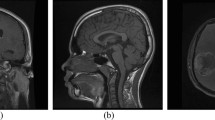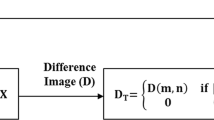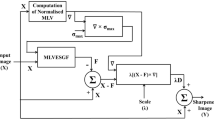Abstract
Well-defined boundaries are necessary to allow precise delineation of morphological structures from magnetic resonance images. Existing state-of-the-art sharpening techniques like unsharp masking (UM) produce discontinuity artefacts and have multiple operational parameters. Tuning multiple parameters together is cumbersome. A computationally efficient and noise robust nonlinear sharpening scheme which is free from discontinuity and saturation artefacts, with very less number of arbitrary parameters, is proposed in this paper. As an inverse mathematical problem, the sharpened image is computed from the amplified first derivative. To constrain the noise amplification, the local value of the amplification factor is considered as a nonlinear function of local average of absolute directional gradients. The proposed sharpening scheme is compared with two of its best possible alternatives, contrast limited adaptive histogram equalization (CLAHE) and UM in terms of sharpness of the output image, thinness of salient edges, feature preservation, saturation and edge quality degradation due to noise, using perceptual sharpness index (PSI), second-order derivative-based measure of enhancement (SDME), edge model-based blur metric (EMBM), structural similarity index metric (SSIM), peak signal-to-noise ratio (PSNR), saturation evaluation index (SEI) and sharpness of ridges (SOR). The proposed nonlinear sharpening scheme exhibited higher PSI, SDME, PSNR and SSIM and lower EMBM, SOR and computational time, compared to CLAHE and UM. The proposed scheme is found to be superior to the existing state-of-the-art techniques like CLAHE and UM, in terms of sharpness as well as thinness of salient edges in the sharpened image, robustness to noise, discontinuity artefacts, saturation and computational time. Because of minimum number of operational parameters, it is user friendly too.







Similar content being viewed by others
References
Datta E, Papinutto N, Schlaeger R, Zhu A, Carballido-Gamio J, Henry RG (2017) Grey matter segmentation of the spinal cord with active contours in MR images. NeuroImage 147:788–799
Zhao Y, Guo S, Luo M, Liu Y, Bilello M, Li C (2017) An energy minimization method for MS lesion segmentation from T1 and FLAIR images. Magn Reson Imaging 39:1–6
Mbuyamba EI, Cervantes JGA, Perez AG, Romero-Troncoso RDJ, Ramos HA, Aceves IC, Chalopin C (2017) Localized active contour model with background intensity compensation applied on automatic MR brain tumor segmentation. Neurocomputing 220:84–97
Khadidos A, Sanchez V, Li CT (2017) Weighted level set evolution based on local edge features for medical image segmentation. IEEE Trans Image Process 26(4):1979–1991
Deng H, Deng W, Sun X, Ye C, Zhou X (2016) Adaptive intuitionistic fuzzy enhancement of brain tumor mr images. Sci Rep 6, Article number: 35760
Ding K, Xiao L, Weng G (2017) Active contours driven by region-scalable fitting and optimized Laplacian of Gaussian energy for image segmentation. Sig Process 134:224–233
Zhang W, Zhao Y, Breckon TP, Chen L (2017) Noise robust image edge detection based upon the automatic anisotropic Gaussian kernels. Pattern Recognit 63:193–205
Joseph J, Sivaraman J, Periyasamy R, Simi VR (2017) An objective method to identify optimum clip-limit and histogram specification of contrast limited adaptive histogram equalization for MR images. Biocybern Biomed Eng 37(3):489–497
Joseph J, Periyasamy R (2018) A fully customized enhancement scheme for controlling brightness error and contrast in magnetic resonance images. Biomed Signal Process Control 39:271–283
Lidong H, Wei Z, Jun W, Zebin S (2015) Combination of contrast limited adaptive histogram equalization and discrete wavelet transform for image enhancement. IET Image Process 9(10):908–915
Contrast Limited Adaptive Histogram Equalization, Documentation. https://in.mathworks.com/help/images/ref/adapthisteq.html
Alasadi AHH, Al-Saedi AKH (2017) A method for micro-calcifications detection in breast mammograms. J Med Syst 41(4):61–68
Deng G (2011) A generalized unsharp masking algorithm. IEEE Trans Image Process 20(5):1249–1261
Unsharp masking, Documentation. https://in.mathworks.com/help/images/ref/imsharpen.html
Krasula L, Le Callet P, Fliegel K, Klíma M (2017) Quality assessment of sharpened images: challenges, methodology, and objective metrics. IEEE Trans Image Process 26(3):1496–1508
Feichtenhofer C, Fassold H, Schallauer P (2013) A perceptual image sharpness metric based on local edge gradient analysis. IEEE Signal Process Lett 20(4):379–382
Guan Jingwei, Zhang Wei, Jason Gu, Ren Hongliang (2015) No-reference blur assessment based on edge modelling. J Vis Commun Image Represent 29:1–7
Panetta K, Zhou Y, Agaian S, Jia H (2011) Nonlinear unsharp masking for mammogram enhancement. IEEE Trans Inf Technol Biomed 15(6):918–928
Hari VS, Jagathy Raj VP, Gopikakumari R (2013) Unsharp masking using quadratic filter for the enhancement of fingerprints in noisy background. Pattern Recognit 46(12):3198–3207
Wang Z, Bovik AC, Sheikh HR, Simoncelli EP (2004) Image quality assessment: from error visibility to structural similarity. IEEE Trans Image Process 13:600–612
Author information
Authors and Affiliations
Corresponding author
Rights and permissions
About this article
Cite this article
Joseph, J., Periyasamy, R. Nonlinear sharpening of MR images using a locally adaptive sharpness gain and a noise reduction parameter. Pattern Anal Applic 22, 273–283 (2019). https://doi.org/10.1007/s10044-018-0763-7
Received:
Accepted:
Published:
Issue Date:
DOI: https://doi.org/10.1007/s10044-018-0763-7




